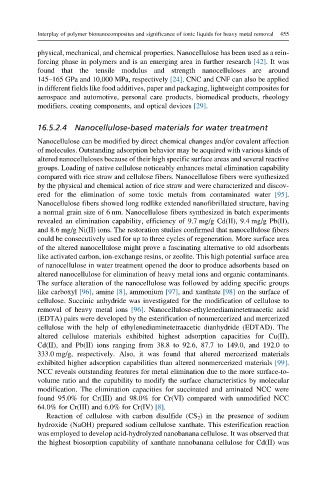Page 502 - Polymer-based Nanocomposites for Energy and Environmental Applications
P. 502
Interplay of polymer bionanocomposites and significance of ionic liquids for heavy metal removal 455
physical, mechanical, and chemical properties. Nanocellulose has been used as a rein-
forcing phase in polymers and is an emerging area in further research [42]. It was
found that the tensile modulus and strength nanocelluloses are around
145–165 GPa and 10,000 MPa, respectively [24]. CNC and CNF can also be applied
in different fields like food additives, paper and packaging, lightweight composites for
aerospace and automotive, personal care products, biomedical products, rheology
modifiers, coating components, and optical devices [29].
16.5.2.4 Nanocellulose-based materials for water treatment
Nanocellulose can be modified by direct chemical changes and/or covalent affection
of molecules. Outstanding adsorption behavior may be acquired with various kinds of
altered nanocelluloses because of their high specific surface areas and several reactive
groups. Loading of native cellulose noticeably enhances metal elimination capability
compared with rice straw and cellulose fibers. Nanocellulose fibers were synthesized
by the physical and chemical action of rice straw and were characterized and discov-
ered for the elimination of some toxic metals from contaminated water [95].
Nanocellulose fibers showed long rodlike extended nanofibrillated structure, having
a normal grain size of 6 nm. Nanocellulose fibers synthesized in batch experiments
revealed an elimination capability, efficiency of 9.7 mg/g Cd(II), 9.4 mg/g Pb(II),
and 8.6 mg/g Ni(II) ions. The restoration studies confirmed that nanocellulose fibers
could be consecutively used for up to three cycles of regeneration. More surface area
of the altered nanocellulose might prove a fascinating alternative to old adsorbents
like activated carbon, ion-exchange resins, or zeolite. This high potential surface area
of nanocellulose in water treatment opened the door to produce adsorbents based on
altered nanocellulose for elimination of heavy metal ions and organic contaminants.
The surface alteration of the nanocellulose was followed by adding specific groups
like carboxyl [96], amine [8], ammonium [97], and xanthate [98] on the surface of
cellulose. Succinic anhydride was investigated for the modification of cellulose to
removal of heavy metal ions [96]. Nanocellulose-ethylenediaminetetraacetic acid
(EDTA) pairs were developed by the esterification of nonmercerized and mercerized
cellulose with the help of ethylenediaminetetraacetic dianhydride (EDTAD). The
altered cellulose materials exhibited highest adsorption capacities for Cu(II),
Cd(II), and Pb(II) ions ranging from 38.8 to 92.6, 87.7 to 149.0, and 192.0 to
333.0 mg/g, respectively. Also, it was found that altered mercerized materials
exhibited higher adsorption capabilities than altered nonmercerized materials [99].
NCC reveals outstanding features for metal elimination due to the more surface-to-
volume ratio and the capability to modify the surface characteristics by molecular
modification. The elimination capacities for succinated and aminated NCC were
found 95.0% for Cr(III) and 98.0% for Cr(VI) compared with unmodified NCC
64.0% for Cr(III) and 6.0% for Cr(IV) [8].
Reaction of cellulose with carbon disulfide (CS 2 ) in the presence of sodium
hydroxide (NaOH) prepared sodium cellulose xanthate. This esterification reaction
was employed to develop acid-hydrolyzed nanobanana cellulose. It was observed that
the highest biosorption capability of xanthate nanobanana cellulose for Cd(II) was

